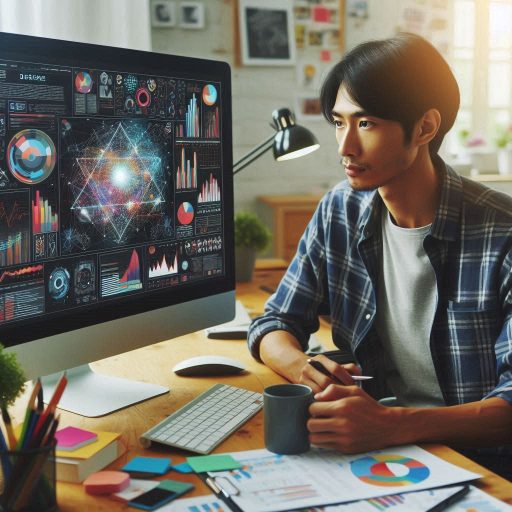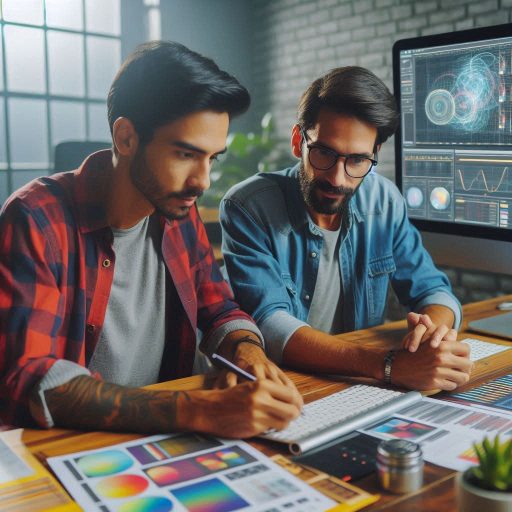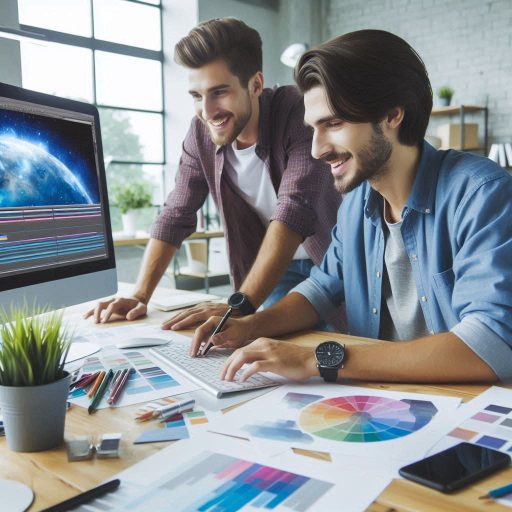Introduction
Motion graphics design involves creating visually appealing animations to convey ideas and messages.
It combines graphic design principles with animation techniques to bring static images to life.
In visual communication, motion graphics play a crucial role in grabbing attention and simplifying complex concepts.
Whether used in advertising, branding, or educational content, motion graphics enhance the overall experience by making information more engaging and accessible.
Motion graphics are essential in a digital world dominated by video content.
Audiences today expect dynamic visuals that capture attention immediately.
Motion graphics allow designers to create visual narratives that leave a lasting impact.
They are used extensively in video marketing, social media content, television commercials, and presentations.
These animations elevate a brand’s message and make it more memorable.
This technique also helps explain complicated topics in a way that’s easy for viewers to understand.
One key technique in motion graphics design is using smooth transitions between elements.
Transitions keep the flow consistent and help guide the viewer’s attention from one part of the animation to another.
These transitions are crucial in maintaining a professional look while ensuring that viewers stay focused on the message.
Designers often use techniques like fades, wipes, and zooms to create seamless movement between different scenes or objects.
Understanding Motion Graphics Design
What Motion Graphics Design Entails
Motion graphics design is a visual art form that blends graphic design and animation to create dynamic content.
It involves moving elements like text, shapes, and images to convey information, tell a story, or evoke emotions.
Unlike traditional animation, which focuses on characters and intricate scenes, motion graphics design emphasizes abstract elements, typography, and visual effects.
Examples of Motion Graphics in Various Forms of Media
Motion graphics can be found across various media platforms.
In advertising, motion graphics are used to create engaging promotional videos.
For example, companies often use animated logos and product demonstrations to capture attention quickly.
On social media, brands use motion graphics to enhance posts and ads, making them more interactive and appealing.
News broadcasts rely on motion graphics for lower thirds, transitions, and visual explanations, providing clarity and emphasis to important information.
In films, opening title sequences often incorporate motion graphics to set the tone for the movie and captivate the audience from the start.
One common example of motion graphics is the use of kinetic typography.
This technique involves animating text to create a sense of movement and rhythm.
It’s widely used in music videos, educational content, and presentations to keep viewers engaged and highlight key points.
Another example is data visualization, where motion graphics transform complex data into visually digestible charts, graphs, and infographics.
This makes it easier for viewers to understand patterns and insights without feeling overwhelmed by raw data.
The Role of Motion Graphics in Enhancing Storytelling and Engagement
Motion graphics significantly enhance storytelling by making abstract concepts more tangible and easier to understand.
Whether in a commercial or a documentary, motion graphics simplify complex data or ideas by transforming them into engaging visual narratives.
For example, an animated chart can present statistical data more effectively than a static report.
This allows audiences to grasp the information quickly and retain it better.
Additionally, motion graphics are highly effective in boosting engagement.
In today’s media landscape, where attention spans are short and content is plentiful, motion graphics capture and hold the viewer’s interest.
Whether through an animated infographic or a character-based explainer video, motion graphics ensure that the audience remains engaged longer.
By blending movement and design, they turn ordinary content into something more immersive and memorable.
Motion graphics design merges animation with graphic design to create engaging, informative content across multiple platforms.
It simplifies complex ideas, enhances storytelling, and boosts viewer engagement, making it an essential tool in modern media.
Essential Tools for Motion Graphics Design
Motion graphics designers rely on several essential tools to create compelling visuals.
Below are the key techniques and tools necessary for successful motion graphics design.
Overview of Popular Software Used for Creating Motion Graphics
One of the most popular software programs is Adobe After Effects.
It provides designers with powerful features for animation, keyframing, and compositing.
Another industry-standard software is Cinema 4D, which excels in 3D motion graphics.
Its integration with other programs like After Effects makes it highly versatile.
Blender is a free, open-source option for creating high-quality 3D motion graphics.
Its growing community and feature set make it an excellent choice.
Designers also frequently use Adobe Illustrator and Photoshop for vector and image creation.
These programs allow users to design static elements, later animated in motion graphics.
Importance of a Strong Foundation in Graphic Design Principles
Having a solid foundation in graphic design principles is crucial for successful motion graphics design.
A good understanding of typography, color theory, and composition ensures a polished final product.
Knowing how to balance elements within a scene helps keep the viewer’s attention focused.
Motion graphics rely on effective visual hierarchy to guide the audience through the content.
Designers must know when and where to place focal points.
A clear understanding of space, scale, and movement gives the design its professional appeal.
Mastering these principles allows designers to create work that is not just visually appealing but also functional.
Incorporating Audio and Video Elements into Motion Graphics
Incorporating audio elements is another key aspect of motion graphics.
Sound effects, music, and voiceovers can dramatically enhance a visual story.
Tools like Adobe Audition allow designers to edit and integrate sound seamlessly into their motion graphics projects.
Well-timed audio can increase the emotional impact of the animation.
Video elements also play a significant role in motion graphics.
Designers often blend live-action footage with animated elements for greater depth.
Programs like Premiere Pro allow for easy video editing and integration with motion graphics.
Combining real-world video and animation can create stunning effects.
Syncing visuals with audio and video elements is crucial for maintaining a cohesive design.
Precise timing ensures the audience experiences the full effect of the motion graphics.
Designers must be adept at layering different media elements together while maintaining visual consistency.
Read: Top Skills Needed for Art Educators and Instructors
Key Techniques in Motion Graphics Design
Animation Principles in Motion Graphics Design
Motion graphics design relies on mastering animation principles like timing, spacing, and exaggeration.
Timing ensures each element moves naturally, with the right speed and rhythm.
Designers control the duration of each action, making the motion feel fluid or sharp, depending on the desired effect.
Spacing, on the other hand, refers to how objects move between frames.
Proper spacing gives depth and realism, helping the viewer perceive weight and momentum in animated elements.
Exaggeration is another vital principle that enhances storytelling in motion graphics.
By amplifying certain movements or expressions, designers capture attention and convey emotions more clearly.
Exaggeration can turn an otherwise flat design into a dynamic, engaging visual.
It’s not about making things look unnatural but rather accentuating key elements to make the message clearer and more powerful.
Creating Smooth Transitions and Movements in Graphics
Another essential technique is creating smooth transitions between graphic elements.
Smooth transitions make the animation feel seamless, ensuring that viewers don’t feel jarred by abrupt changes.
Designers often use easing techniques to control how fast or slow objects move between keyframes.
This gives a polished, professional look to the animation.
Easing adds realism by mimicking the natural acceleration and deceleration of objects in motion.
Using Typography and Color Effectively in Motion Graphics
Motion designers also focus on using typography effectively.
In motion graphics, typography isn’t just text; it’s a design element that guides the viewer’s eye.
The way text moves, its size, font choice, and spacing all contribute to how the message is perceived.
Designers may animate typography to appear, disappear, or shift around the screen to emphasize certain points.
Animated text must be clear, engaging, and synchronized with other elements of the design.
Color also plays a crucial role in motion graphics design.
Color choices can enhance mood, direct attention, and create harmony between different elements.
For example, bold colors may draw attention to important features, while softer colors may be used to create a calming or neutral background.
Motion designers must think carefully about how color interacts with other components, ensuring it enhances rather than overwhelms the visual story.
Mastering these techniques—timing, spacing, exaggeration, smooth transitions, effective typography, and thoughtful color use—is essential for success in motion graphics design.
They ensure that animations are not only visually appealing but also functional, conveying the intended message clearly and engagingly.
Applying these techniques consistently helps motion designers create captivating experiences that resonate with viewers.
Read: Historic Costume Design Inspirations
Incorporating 3D Elements in Motion Graphics
The Use of Three-Dimensional Objects in Motion Graphics
Incorporating 3D elements in motion graphics can elevate a design’s visual appeal and storytelling.
Three-dimensional objects offer a dynamic way to enhance motion graphics by adding depth and realism.
Designers can use 3D models to create more engaging and immersive animations, capturing the audience’s attention more effectively.
When incorporating 3D elements, it’s important to balance them with 2D elements for a cohesive look.
Tips for Creating Depth and Dimension in 3D Motion Graphics
To create depth and dimension in 3D motion graphics, consider using lighting and shadows effectively.
Proper lighting can bring out the intricate details of 3D models, giving them a more realistic feel.
Shadows, when used correctly, add depth by making objects appear grounded in a scene.
Utilizing perspective is another essential technique for creating dimension in 3D motion graphics.
By adjusting the camera angles, designers can simulate distance and scale, giving the impression of a larger space or multiple layers within the animation.
Textures also play a key role in enhancing the realism of 3D objects.
Applying appropriate textures to models can mimic surfaces like wood, metal, or fabric, giving the object a tangible quality.
Be mindful of texture resolution to avoid a pixelated or blurry appearance.
Another tip for creating depth in 3D motion graphics is to incorporate camera movements.
Smooth pans, zooms, and rotations can add a cinematic quality to animations, drawing viewers deeper into the scene.
Tools and Techniques for Integrating 3D Elements Seamlessly
When integrating 3D elements into motion graphics, choosing the right tools is essential for a seamless workflow.
Popular software like Cinema 4D, Blender, and Autodesk Maya offer robust features for 3D modeling and animation.
These tools allow designers to build and manipulate 3D objects with precision, giving them full control over the final output.
Adobe After Effects is another powerful tool that supports 3D elements and allows for easy integration with other design software.
Plugins like Element 3D make it easier to bring 3D models into After Effects for smoother animations.
Another useful technique for seamless integration is rendering 3D elements separately and compositing them with 2D assets.
This approach allows for greater control over the final look of the animation and makes it easier to adjust individual elements without affecting the entire composition.
Additionally, using motion blur can help blend 3D objects with 2D animations, making transitions appear smoother and more natural.
Incorporating 3D elements into motion graphics requires thoughtful planning and execution.
By focusing on depth, dimension, and the right tools, designers can seamlessly blend 3D with 2D to create visually captivating animations that stand out.
Read: Networking Events for Costume Designers

Adding Visual Effects to Motion Graphics
Utilizing Visual Effects to Enhance the Overall Look of Motion Graphics
Adding visual effects to motion graphics can significantly enhance the visual appeal and storytelling.
By using effects like particle systems, light leaks, and glitch effects, designers can create captivating and immersive animations.
These effects give motion graphics depth, texture, and an engaging dynamic that captures the audience’s attention.
Using Effects Such as Particle Systems, Light Leaks, and Glitch Effects
Particle systems allow designers to simulate natural phenomena like fire, smoke, or rain.
This effect is highly customizable and adds a sense of realism or fantasy.
For example, a particle system can be used to show digital sparks during a tech-themed animation.
It can also enhance environmental effects, such as snowfall or glowing embers in a visually stunning way.
Properly implementing particle systems can elevate simple animations into more elaborate designs.
Light leaks are another popular visual effect that enhances the overall look of motion graphics.
This effect mimics real-world light exposure, creating a warm, nostalgic, or cinematic feel.
Light leaks are typically used in transitions or to draw attention to key elements within the motion graphic.
Using this effect with subtlety can add emotional impact and highlight important moments without overwhelming the audience.
Glitch effects are powerful for creating high-energy and futuristic designs.
Glitches simulate technical malfunctions, often producing broken, distorted visuals that appear intentional.
This effect is perfect for tech-related themes, gaming visuals, or any project needing a bold, edgy style.
Designers should carefully control glitch effects to avoid making the visuals chaotic or difficult to follow.
When used properly, glitches add complexity and a modern aesthetic to motion graphics.
Tips for Creating Visually Stunning and Dynamic Motion Graphics
To create visually stunning motion graphics, designers must balance these effects carefully.
Overusing visual effects can result in a cluttered or distracting animation.
Instead, each effect should be applied with purpose, enhancing the overall design without taking away from the key message.
Simplicity in motion graphics can sometimes have a greater impact than filling every scene with effects.
Layering different visual effects can also add depth and richness.
Designers might combine particle systems with light leaks to create a soft, ethereal look or pair glitch effects with fast transitions for a futuristic vibe.
Experimenting with combinations can help create a unique and memorable style.
Finally, maintaining smooth animation and pacing is essential for creating dynamic motion graphics.
Visual effects should blend seamlessly with other design elements to ensure the flow remains consistent.
Pay close attention to timing and transitions when adding effects.
This ensures that the visual effects enhance rather than disrupt the viewer’s experience.
Incorporating visual effects into motion graphics takes creativity and precision.
By applying particle systems, light leaks, and glitch effects thoughtfully, designers can craft dynamic, visually stunning animations that leave a lasting impression.
Transform Your Career Today
Unlock a personalized career strategy that drives real results. Get tailored advice and a roadmap designed just for you.
Start NowRead: Visual Merchandiser: Job Market and Opportunities
Interactive Motion Graphics Design
Interactive motion graphics design brings a dynamic layer to visual storytelling.
It allows viewers to engage directly with content, enhancing their overall experience.
Incorporating interactive elements transforms static designs into immersive environments.
This innovation captivates audiences and keeps them involved.
Incorporating Interactive Elements into Motion Graphics for a Unique User Experience
One effective way to engage users is through animated infographics.
These visuals present complex data in a digestible format.
They simplify information, making it accessible and enjoyable.
By using animations, designers can highlight key data points, guiding viewers through the narrative.
This approach helps audiences grasp information quickly and effectively.
Another technique involves creating interactive data visualizations.
Designers can use tools like D3.
js or Adobe Animate to make data come alive.
These tools enable users to explore data through clicking, hovering, or dragging.
For instance, an interactive map can show changes over time.
This kind of visual representation makes statistics engaging and informative.
Creating Animated Infographics and Data Visualizations
When designing interactive motion graphics, consider the user experience.
Start with a clear purpose for your project.
Understand what you want to convey and how users will interact with it.
Define your target audience to tailor your content accordingly.
Knowing your audience helps you create relevant and appealing graphics.
Keep usability in mind while designing interactive elements.
Ensure that users can navigate your graphics intuitively.
Use familiar icons and straightforward layouts to guide them.
Test your designs with real users to identify any obstacles they encounter.
Their feedback will help you refine the experience.
Tips for Designing Interactive Motion Graphics That Engage and Captivate Audiences
Another essential tip is to balance interactivity and aesthetics.
While engaging features are crucial, the overall design must remain visually appealing.
Avoid overwhelming users with excessive animations or too much information.
Strive for harmony between the interactive elements and the overall design.
Incorporate storytelling into your interactive motion graphics.
A compelling narrative keeps users interested and encourages them to explore further.
Use sequential animations to guide them through the story.
This method not only informs but also entertains viewers, enhancing their connection to the content.
Finally, keep your graphics responsive across devices.
Ensure that they work seamlessly on desktops, tablets, and smartphones.
A responsive design maximizes accessibility and encourages broader audience engagement.
By optimizing for different screen sizes, you reach more users effectively.
Essentially, interactive motion graphics design offers endless possibilities.
By incorporating interactive elements, you create engaging experiences that captivate your audience.
Utilize animated infographics and data visualizations to enhance understanding.
Follow best practices in usability and aesthetics to maximize impact.
Design with storytelling in mind and ensure responsiveness for a truly immersive experience.
Motion Graphics for Different Platforms
Motion graphics design plays a crucial role in effective communication across various platforms.
Each platform has unique characteristics and audience preferences.
Therefore, designers must tailor their motion graphics to meet these specific needs.
Let’s explore the essential techniques for optimizing motion graphics for different platforms.
Tailoring Motion Graphics Design for Specific Platforms
Social media platforms, such as Instagram and Facebook, have distinct formats and audience behaviors.
Designers should create short, engaging animations that capture attention quickly.
For instance, a quick loop or a dynamic title can draw users in as they scroll through their feeds.
Content for social media should be concise and visually striking, making it easy to consume on the go.
Websites also demand tailored motion graphics.
Designers must ensure that animations enhance the user experience without causing distractions.
For instance, subtle animations can guide users’ attention to key areas, such as calls to action.
Designers should consider load times and file sizes, ensuring that graphics do not slow down page performance.
Video presentations often allow for more detailed motion graphics.
Designers can incorporate complex animations that illustrate concepts effectively.
However, clarity remains essential; the audience should easily understand the message.
Effective transitions and visual hierarchies can enhance the storytelling aspect of the presentation.
Adapting Motion Graphics for Mobile Devices and Responsive Design
Mobile devices introduce additional challenges for motion graphics design.
The smaller screens require designers to simplify visuals and text.
Animations should be legible and engaging even on compact displays.
Designers must consider finger touch targets, ensuring that interactive elements are easily accessible.
Responsive design is another critical aspect to consider.
Motion graphics must adapt seamlessly across various screen sizes.
Designers should use scalable vector graphics (SVGs) to maintain quality on different devices.
This approach ensures that animations remain sharp and visually appealing, regardless of the platform.
Understanding the Technical Requirements and Limitations of Different Platforms
Understanding the technical requirements of each platform is vital for effective motion graphics design.
Each platform has specific guidelines regarding file formats, dimensions, and aspect ratios.
For example, while MP4 files work well for videos, GIFs are ideal for social media posts.
Designers must stay updated on these specifications to ensure their graphics display correctly.
Limitations, such as file size and playback performance, also influence design decisions.
Designers should optimize their animations to minimize loading times and bandwidth usage.
Reducing the frame rate or simplifying complex animations can help achieve this goal.
In short, tailoring motion graphics for different platforms is essential for successful communication.
By understanding each platform’s requirements and limitations, designers can create compelling, effective animations.
This approach enhances user engagement and ensures that the intended message reaches the audience effectively.
As technology continues to evolve, adapting motion graphics design will remain crucial in a dynamic digital landscape.
Conclusion
In this blog post, we explored essential techniques in motion graphics design.
We discussed the significance of understanding animation principles and timing.
Key techniques like layering, masking, and keyframing help create engaging motion graphics.
Effective use of color and typography enhances visual storytelling.
Additionally, we covered the importance of audio integration to elevate your projects.
Experimentation with different styles and tools can lead to unique results.
Using software like After Effects or Blender allows for diverse creative expressions.
As you embark on your motion graphics journey, remember to innovate.
Don’t hesitate to push boundaries and explore new ideas.
Experimentation often leads to unexpected and exciting results.
Incorporate various techniques and find what resonates with your style.
Continuous learning is crucial in this rapidly evolving field.
Stay updated on the latest trends and technologies in motion graphics.
Follow industry leaders, attend workshops, and engage in online communities.
This commitment to growth will keep your skills sharp and relevant.
Networking with fellow designers can provide invaluable insights and inspiration.
Sharing experiences and techniques can foster a supportive creative environment.
Collaborating with others can also enhance your portfolio and expand your opportunities.




